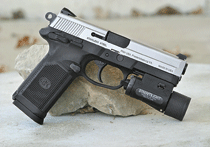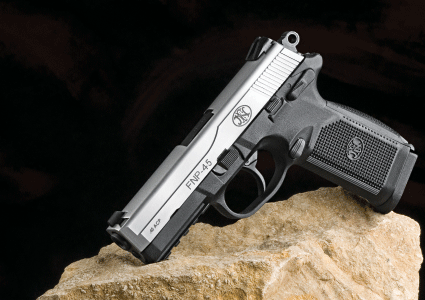SOME TIME BACK, the United States Armed Forces began casting around for a polymer-frame, double-stack .45 autoloading pistol for certain service members to take into battle. There was time, effort and money spent – quite a bit – by various manufacturers who each wanted to provide this new US military service pistol.
 After getting past several hurdles, the Government made a decision: They weren’t going to buy any pistols. That left a number of tried and proven designs that had no military home. The manufacturers ramped up to make up the loss of development time and effort and we have a number of reliable, solid .45 pistols coming to market. One of these is the FNP-45.
After getting past several hurdles, the Government made a decision: They weren’t going to buy any pistols. That left a number of tried and proven designs that had no military home. The manufacturers ramped up to make up the loss of development time and effort and we have a number of reliable, solid .45 pistols coming to market. One of these is the FNP-45.
Gun Details
FNH USA simply upsized their current FNP (FN Pistol) line and made it in .45ACP. Interestingly, it appears that the design could well have included a manual safety based on the frame depression where the decocker travels. The decocker is pressed down to safely lower the cocked hammer and return the pistol to trigger-cocking mode (always point the pistol in a safe direction, especially when lowering the hammer muzzle direction is obviously very important).
Advertisement — Continue Reading Below
The decocker depression in the frame extends up to the top of the frame. I tried pushing the decocker up; it’s obvious the frame was made for this, but the decocker wouldn’t go up. I believe the military was interested in a manual safety.
I’ve not tried the latest iteration of the FNP-45, but it may have the manual safety.
I got to shoot a couple of versions of the FNP-45 last year at a press gathering put on by FNH USA. The triggers were about standard for DA/SA-type pistols. The slides are big and blocky, but these are big pistols in a big caliber. The sights were good and they seemed to be accurate. They were reliable with the FMJ ammo we were shooting. I was promised a T&E model. It arrived a couple of weeks ago.
Advertisement — Continue Reading Below
Housed in a large plastic luggage case, the biggest lockable pistol case I’ve ever seen a new pistol shipped in, the FNP-45 is supplied with three magazines, which is nice. A flat backstrap is included. The pistol is supplied with the arched backstrap in place.
Inside the hollow lid of the pistol case, there is a lock, an envelope with a fired case and the owner’s manual.
Staying with the DA/SA trigger system with a decocker, FNH USA has moved away from the current wisdom of a single trigger pull in length and weight.
Advertisement — Continue Reading Below
The organizations that stick with the double-single-action guns have reasons. The first issue raised is that the trigger pull with the hammer at rest is very long and heavy, which should minimize the chances of an accident. I’ve not run across a handgun trigger that’s so heavy one can’t accidentally fire a shot.
Another long-held excuse is the remaining rounds in the gun require a short, light trigger pull to fire. If we’ve been surprised by a close range threat, that first long pull should still be precise enough to hit the threat. The single-action trigger is handy if a criminal offender steps behind cover or a hostage. The precise shot so enabled will end festivities, if the officer will take the shot.
The arguments aren’t invalid. I think they run contrary to what I often see on the range. I’ve recently had a few people out to train who have shown up with the DA/SA setup and they’ve done fine. I’m not the final arbiter of what’s good and what isn’t. And, if there wasn’t a market for that trigger system, FNH wouldn’t make them.
Advertisement — Continue Reading Below
The FNP-45 is neither the thickest nor the biggest double-stack .45 we’ve handled. The long reach to the double-action trigger keeps it from being truly comfortable in my hands. It’s not bad for many others.
The new gun has interesting aspects as well. There is a slide release lever on both sides of the new gun. I could take or leave them. The decocking lever is likewise on both sides of the gun. That is a handy device to have in mirror image. I don’t want southpaws shifting their grips or, worse yet, lowering the hammer by holding it steady with a thumb while pulling the trigger. That’s no way to get the hammer down.
The magazine release button is ambidextrous. I can already hear some yawns out there. For right-handed shooters, the magazine release button on the right side of the frame makes it accessible to the right index finger. It can’t be on the trigger during a magazine change and it has to be somewhere, why not using it to dump the old magazine?
Advertisement — Continue Reading Below
I have to shift the pistol in my grip to get at the magazine release button with my right thumb. Not so when using the right index finger. This clears the huge magazine well for the tapered top end of the replacement magazine. It’s a fast-reloading sidearm. And it should take a long string of shooting to be forced to reload; the magazine capacity is fourteen .45ACP cartridges! That’s a lot of weight in that polymer grip frame. With three magazines, there are 43 rounds of ammunition available before we’re reduced to fisticuffs.
The magazines have numbered witness holes at the rear instead of the sides of the magazine.
The frame’s dustcover has an integrally molded M1913 rail for various flashlights and laser aimers. I put an Insight Tech-Gear M3X light on the gun. The gun’s serial number plate is embedded in the dustcover. On the serial plate, the serial number is engraved below the bar code depicting that number.
Advertisement — Continue Reading Below
The left side of the frame has the disassembly lever in front of the slide release lever and decocking lever. The gripping part of the frame has raised lines on the front- and back-straps. The sides of the grip frame have sharp checkering. There are no front cocking serrations. This doesn’t bother me as I don’t use them.
The sights are black, low profile and are fitted into dovetails in the stainless steel slide. White dots are painted on the rear sight on either side of the rear sight notch. The front sight has a corresponding front sight.
Another plus for the FNP-45 is the easy disassembly for cleaning. To field strip the new FN, remove the magazine and stow it. Lock the slide to the rear, checking for ammunition in the chamber. If it’s clear, rotate the disassembly lever 90° clockwise. Pull the slide to the rear, freeing it from the slide release levers. Let the slide forward slowly, controlling its travel. Continue moving the slide forward until it clears the frame. Put the frame aside and turn the slide upside down. Compress the recoil spring and lift it from the gun. Lift the barrel clear from the slide. That’s all there is to it.
Advertisement — Continue Reading Below
How It Shoots
I was suitably impressed with the FNP-45. It doesn’t beat the shooter up. The rear of the gun is wide enough to minimize any discomfort to the hand. It’s a treat to load 14 rounds into those new magazines, but that’s common with any double stack pistol magazine.
The trigger is stout in double-action. It’s supposed to be. Chuck Haggard and I found out that it wasn’t so onerous that it prevented good quick hits up close. At distance, that could be another issue. Single-action was light and short with quite a bit of take-up and some creep.
The FNP-45 easily handled all types of .45ACP including some hard-shooting +P stuff. I found my best work was with hardball, which is pretty common for me these days. Harder shooting stuff tends to rattle me.
Advertisement — Continue Reading Below
One string from a hard supported barricade position yielded a 50-yard, vertical stringing pattern of about 4.75 inches in length. This was fired all single-action, using Federal American Eagle 230-grain FMJ. The remainder of accuracy work was done at fifty feet hand-held, supported. The single-action trigger was easy enough to work with that groups stayed under three inches.
Attempting to do a handling exercise was hampered by the fact I didn’t have a holster to fit the large slide. That said, making pairs was no problem. We had no stoppages with any ammo we tried.
Chuck Haggard got behind the FNP-45 and gave it a workout. He’d fired one before at a law enforcement vendors’ soiree and came away impressed. The accuracy and fit stood out for him. He noted that the flat backstrap fit his hand even better than the arched that was affixed to the gun in shipping.
On another range day, the FNP-45 was given an accuracy workout. The distance was 50 feet, not our normal 25 yards. Federal American Eagle ball put five rounds in-to 2 inches. With Winchester USA 185-grain FMJ, I was able to shoot a 1.5-inch group. CorBon’s 185-grain DPX +P was good for 1.63 inches and their 230-grain JHP +P load yielded a 2.5-inch result. Hornady’s excellent 200-grain XTP put five bullets into 1.5 inches.
That performance, taken along with the best 50-yard effort, tells me the FNH FNP-45 performs with somewhat better than service accuracy. We also found that the FNP-45 was reliable with a range of readily available .45ACP ammunition. I also fired a few vastly outdated .45 specialty loads, not all known for their ease of feeding. The FNP-45 fed them all and asked for more.
Service .45
The FNH USA FNP-45 is a large, robust and reliable service-size .45ACP with greater than average service accuracy. Chuck Haggard said that the FNP-45 has the best ambidextrous magazine release he’s used.
“I like the aggressive checkering, too,” he said. He’s been known to grace his working iron with skateboard tape and other “hard grip” materials. I noted that you wouldn’t lose your hold on the FNP-45 in a rainstorm.
I asked about his perception of the 45’s size. “It fits me,” he said. While noting all the things he likes about the FNP-45, his only gripe was the trigger. “I’d have to get used to that trigger,” he said.
I agree. With a modular design given to a short and easy armorer’s school, it’d be a good choice for agencies and users who require a double-to-single-action design pistol.























